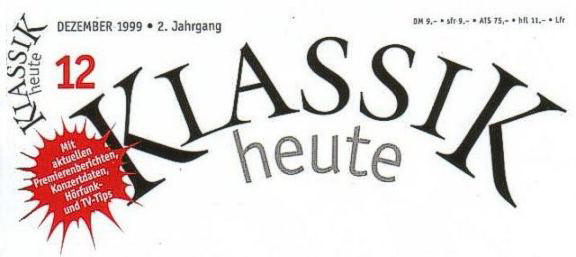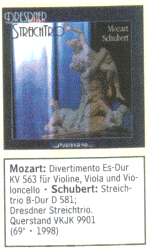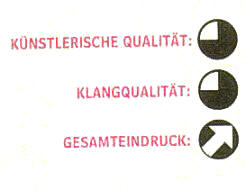reviews
seenandheard-international.com
Fine playing of Lennox Berkeley by Dresden Trio
Germany, Semperoper, Dresden, 19.02.2014 (SRT)
Sir Lennox Berkeley: String Trio (1944); Wilhelm Berger: String Trio in G Minor, Op. 69; Beethoven: String Trio in G, Op. 9 No. 1
British readers and listeners will find it heartening to see a prestigious German ensemble playing the music of Lennox Berkeley, and it is even more heartening that they did it so well. The Dresden String Trio got right into the edgy, turbulent world of the outer movements, but were at their best in the central Adagio, an oasis of peace that seemed to let time stand still for a few gorgeous moments. Wilhelm Berger, on the other hand, was a new name to me, but perhaps that’s because he would win few prizes for originality. The first movement of his G minor trio sounded very close to the world of Brahms, while the slow(ish) second movement is a set of variations that sound like something a late-Romantic Haydn would have written. Likewise, the finale centres on a bucolic melody that Schubert would have been proud to call his own, full of the rhythms of what feels like a peasant dance. Two of the members of the Dresdner Trio are drawn from the regular players of the Dresden Staatskapelle (the third is principal cello of the MDR Symphony Orchestra in Leipzig), and together they make a class act. You can’t be part of such a world-leading orchestra and not know a thing or two about how to listen, and that means they are at the top of their game when it comes to chamber music. Their sound has a wonderfully rich, mahogany-brown character that seems to ooze luxury, and they have worked so hard on their blend that it was sometimes difficult to tell cello and viola apart. That, surely, was the plan all along, and the richness of their middle registers was the secret to their success. It lent a real touch of luxury to their playing of these first, lesser known works, but also served up predictable delights with Beethoven’s G major Trio, which sparkled and fizzed once the opening Allegro got underway, and had the energy of a firecracker in the finale. Best of all, though, was the slow movement. JörgFassmann spun the opening violin melody as one great, breathed-out line, almost like an operatic aria, and this led to the most conversational playing of the night, culminating in a sensitive swell in the final chord. I was pleasantly surprised that the sound never came close to being lost in the large space of the Semperoper, not an auditorium one naturally associates with chamber music. It helped that they only used the two lowest levels of seating, but it will also have been part of the musicians’ knowledge and experience of the acoustic. As a final treat in his anniversary year, they played a set of variations by a youthful of the acoustic. As a final treat in his anniversary year, they played a set of variations by a youthful Richard Strauss, a most appropriate way to round off a hugely satisfying recital.
Simon Thompson
Chamber music evening of an international class
Captivating Goldberg variations
"Dresden string trio is a brilliant ensemble, meanwhile known beyond national boundaries… they felt, listen and played themselves into Bach's dreamily profound tone cosmos so cautiously, filled it with such an aesthete and enjoyment, took their time for the shades of the dance-like gallantry and intimacy, that we wanted to sink in their tone clouds which are gentle and always well-tempered. THE WORLD [Die Welt]
Of because of epigone!
"The three musicians feel everything easy and conclusive and it is of a true inclination to listen to the warm tones, the lively phrases and Brahms' turns.
… they success in a true and at the same time silverly-sounding ensemble tone which might stand really alone in the trio landscape.
www.Klassik.com
Enormous tone volume
"A graceful melodious sound was combined with dignified depth. On the safe basis of a virtuoso, light-handed harmony, humorously funny tone plays conform smoothly to melancholy clay tunes. The coaxing perfection of the ensemble was impressing – seemingly played by more than three instruments, measured in terms of the tone volume.
"Westphalian indicator [Westfälischer Anzeiger]
A Dresden string trio charmed the audience
"Because of its piquant transparency and because of its intrinsic value, the trio induced approval storms by the experts in polyphonic matters as well as made B-A C-H as a transcription of the "Goldberg variations" admirable, genuine, charming and fantastic. It was probably the noblest which has happened to the studio stage till now."
Thuringian general [Thüringer Allgemeine]
A great moment of the chamber music
"… all together solo musicians at known orchestras, clear what it is for them when playing together : high tone culture, greatest possible homogeneity, a common and free breath, finest articulation and transitions, colour the lines up to the last angles.
in the fantastic interpretation of Beethoven’s early string trio op. 3 E flat major – Storm and Stress glooming - at the end of the evening: Nothing was never groused effectively, shown off with Olympic record tempi. The three took their time for final phrases, preferred to infer with a sigh than with a bang, put accents always appropriately and never being noisy.
One was allowed to enjoy, to admire, be moved and astonished… “
Swabian newspaper [Schwäbische Zeitung]
Valuables of the chamber music
Dresdner string trio in the Frauenkirche
"However, the success of the evening was not only due to the musical quality of the programme but primarily in the high standard of its rendition. The interpretations were intensive and subtle, balanced and precise, very alive, as one can only experience if three musicians are so smoothly and sensitively committed to each other like in this case. There were no differences in the formal and instrumental knowledge and intention.
A perfect dream was also the quietly fluent adagio - an oasis of filigree tone beauty. The Dresden string trio is to be payed the highest praise for this closed, expressive and thrilling interpretation. “
DNN DresdnerNeuesteNachrichten
top work concerning chamber music in the margravial opera house Bayreuth
"Aromatic tunes and vigorous play seduced the audience from the beginning into the highest concentration. I have never heard such quietness driven to the extreme in a public concert before than in this clear interpretation of Mozart's only string trio. The whole opus of six sentences seemed to consist of one single fine organism of softest tone branching, sometimes lifted in celestical spheres.“
Cure North-Bavarian [Nordbayerischer Kurier]
|
|
|||||
|
|||||


